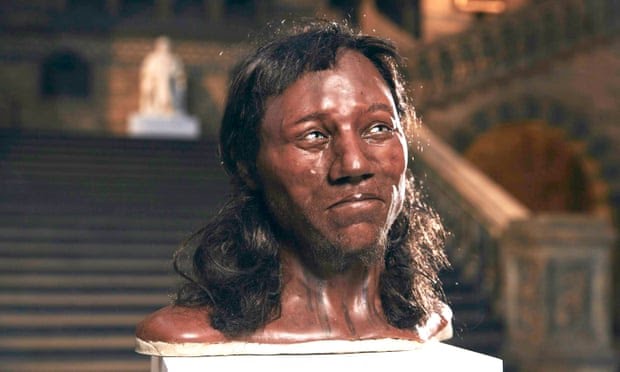The study of a 10,000-year-old man surprised people when it revealed his blue eyes and dark skin – and few predicted he would reshape our view of our genetic heritage
By Robin McKie
In 1903 workmen digging a drainage trench in Gough’s Cave in the Cheddar Gorge, in Somerset, uncovered the remains of a young man, sealed under a stalagmite. The figure, feet curled up underneath him, was small, at about 5ft 5in, and would have weighed around 10 stone when he died in his early 20s. The cause of death has still not been determined by palaeontologists.
The skeleton’s antiquity was revealed when fossil experts dated his bones and realised that Cheddar Man, as he quickly became known, was almost 10,000 years old. This is still the oldest virtually complete skeleton that has been unearthed in the British Isles, although it is unclear whether the young man died in the cave or was brought there by fellow tribesmen and was then buried there.
His antiquity has since ensured his importance to historians and scientists who study how the British Isles were populated – a topic that went viral when geneticists published new research that showed the young man would have had black hair, blue eyes – and dark skin.
A great many widely held – but incorrect – assumptions about the expected pale-skinned, fair-featured nature of Britain’s founders were promptly overturned, to the rage of some commentators and the joy of many. “I just wish I knew about you when I was growing up and people asked me where I was ‘really’ from. North London, bruv,” the Labour MP David Lammy tweeted.
The news was certainly intriguing, for apart from revealing some home truths about the implications of how skin colour can change over time, the new research underlines some essential and unexpected features about the ancestry of the British people. According to one geneticist involved in the latest study of Cheddar Man, Mark Thomas of University College London (UCL), it is now clear that about 10% of our genes come from the mesolithic hunter-gatherer folk, of which Cheddar Man was a member.
“That does not mean that 10% of the British population today is descended directly from him,” cautioned Thomas. “It means that the average person in Britain today carries around 10% of the genes of these ancient hunter-gatherers.”
Thus the DNA of Cheddar Man shows there is a 10,000-year-old unbroken genetic lineage from people who inhabited Britain long before agriculture reached our shores to British men and women of today. We are not a nation of farmers (or shopkeepers, for that matter) but can trace our ancestry to nomadic hunters, who – 300 generations ago – carved antlers to make harpoons for fishing, used bows and arrows, and trained dogs that would have assisted them in the hunt for animals such as red deer, aurochs and boar, as well as protecting their masters from competing predators such as wolves.
Cheddar Man was a member of a population of nomadic hunters who thrived during the middle stone age, also known as the mesolithic age, about 10,000 years ago. These were the western European hunter-gatherers, whose remains have been found in Spain, Luxembourg and Hungary. Crucially, the DNA of these people also shows they had dark skin and blue eyes and were similar, genetically, to Cheddar Man.
At this time, Britain was a peninsula of northern Europe, linked by an area of land that now forms the seabed of the southern North Sea and the Channel. As a result, nomadic people, often following migrating animals, undertook frequent visits and made the most of the British landscape, which was then flourishing in the wake of the retreat of the glaciers that had covered the country a few thousand years earlier.
But change was at hand. Like the rest of the world, Europe was continuing to warm, and ice caps were melting, raising sea levels. Around 8,000 years ago, the last land connection between Britain and Europe – a stretch of terrain called Doggerland, which linked north Norfolk with Holland – was inundated. Britain became an island, and the few thousand individuals who were then roaming its forest and heaths in search of food were isolated. By accident, these hunter-gatherers became the founding mothers and fathers of Britain.
It is an intriguing scenario which raises a host of questions. If these dark-haired, dark-skinned people were the nation’s founders, what happened to our complexions in the intervening millennia? What triggered the emergence of the pale aspect of the typical Brit?
Chris Stringer of the Natural History Museum in London traces the cause to the first farmers who reached our shores around 6,000 years ago, as agriculture spread eastwards after its birth in the Middle East several thousand years earlier. “These farming people would have had relatively poor diets, based only on one or two cereal crops, and would have lacked vitamin D. By contrast, hunter-gatherers, although few in number, probably had very healthy diets with lots of fish and liver that were rich in vitamin D. Cheddar Man had very healthy teeth, which suggests a good diet, for example.”
Diets low in vitamin D would have had an impact on these early farmers, who would have developed soft bones, skeletal deformities and other problems. However, vitamin D is also created underneath our skin in response to sunlight. As a result, nutritionally deprived farming folk evolved lighter skin in order to boost their vitamin D, while gene variants for dark skin disappeared. Genes for lighter skin were brought to our shores by these farming people.
“Farming may have provided poorer diets in those days but it also allowed far greater numbers of people to live per acre of land compared to those who lived as hunter-gatherers,” added Stringer. “In other words, they had the numbers and so, once farming became established in Britain, the genes for lighter skin would have taken over the population.”
The existence of blue eyes, also revealed by the Cheddar Man geneticists, is more difficult to explain. “Using classic genetic surveys, it was thought that blue eyes first appeared in humans between 6,000 and 10,000 years ago,” said Thomas. “Now studies of ancient DNA are showing it was already well established in some populations.”
How it became established is not known, however, nor is it clear that it conferred any evolutionary advantage on those blessed with blue eyes.
“The continent was awash with migrations, and it may be that the trait was just picked up and passed on to us,” added Thomas.
This last point is also crucial. Ten or 20 years ago, many historians and archaeologists argued against the concept that new fashions and technologies, from metalworking to agriculture, were passed on as ideas and were not imported directly. “Genetics has shown this is simply not the case,” added Thomas. “It is now very clear that migration has been the standard agent for bringing about cultural change.”
This point was endorsed by Dr Richard Bates of St Andrews University. “When we do more of this kind of deep genetics, on other ancient remains, we are going to find an incredible diversity among the people of this time,” he said.
Our predecessors moved around a lot more, he added, and were able to move far greater distances than we have given them credit for until now.
“It is only when farming arrived that we became sedentary, and when that happened we also got the concept of land ownership and with it the idea of defence – and in its wake came conflicts,” said Bates. “It took generations to occur, and it happened in many other parts of the world. Nevertheless, it was the biggest social change that ever affected our species. The story of Cheddar Man gives us a feeling for the profundity of that change.”
•Opinions, positions or thoughts expressed here are personal and strictly of the writers/author and not The Daily Crucible.
•The article first appeared in The Guardian of London over 6 years ago.









































